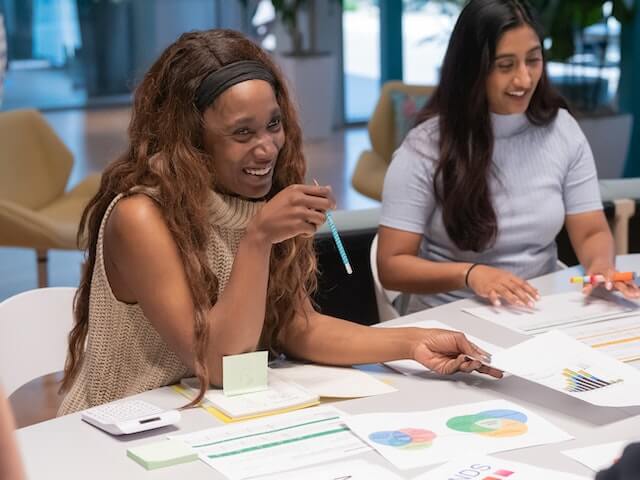Learn to make a good gamification strategy! Have you ever wondered how to get your clients, employees or students to feel more engaged with what are you doing? Well, we have good news, because gamification is one of the most powerful tools we currently have to engage people in various fields.
From GumsUp we want to explain to you Step by Step which is the best way to make a gamification strategy that suits your goals. Start getting the most out of your actions with these simple tips.
Benefits of gamification in different contexts
Before starting with the points to take into account to make a gamification strategy, it is good that know all the advantages that this tool can bring to your workplace. These are some of the best benefits of creating a good gamification strategy:
- Increased motivation: By incorporating game elements such as competitions, objectives and rewards, you will be creating a more engaging and stimulating environment that will naturally motivate participants. In this post we give you group dynamics to motivate.
- Learning Enhancement: Gamification is an effective tool in the educational field, as it can help students retain information more effectively. The learning process becomes an interactive experience and participation is encouraged, factors that facilitate the understanding and assimilation of the most complex concepts.
- Increase in participation: The game mechanics create a sense of progression, which motivates the participants to continue participating and improving themselves.
- Encourage teamwork: Many of the games in which gamification is supported are group challenges with which shared rewards are acquired. This is a good way to get your users to collaborate with each other and support each other.
- Influencing people's behavior: Gamification establishes goals that must be reached to receive rewards and this encourages specific behaviors, such as completing tasks on time, following healthy routines or adopting positive habits.
- Create experiences to remember: The platforms that work through gamification combine visual, narrative and interaction elements that will capture the attention of users and allow them to live an immersive experience that will last in their memory.

Preliminary steps to make a gamification strategy
Gamification is not a process in which you can improvise, but each of the steps by which it is composed, have been perfectly studied and adapted to the field in which you want to work. In order to guarantee effective results, you must understand the importance of each of the stages that you must go through.
Defining clear and measurable objectives
Establishing clear and measurable objectives is essential for your gamification strategy to achieve the results you expect. The first thing you have to consider is What do I want to achieve through gamification?
You can choose answers such as: increase user participation, improve learning, encourage collaboration or promote the fulfillment of specific objectives in a specific timing. It is important that identify and define the results desired and that these are specific, measurable, achievable, relevant and temporary (SMART).
Design of game mechanics and dynamics
Once you have established your goals, it is time to design the mechanics and game dynamics that you are going to use and in which you are going to rely on in your gamification strategy. At this point you should identify the elements of the game that are most effective in your case.
You can focus on rewards, levels, challenges, competition, collaboration, narrative, progression, etc. The design of these tools must be closely related to the objectives and must be adapted to the characteristics and preferences of the public to which they are directed.
Identification of the target audience and adaptation of the strategy
To achieve maximum impact with gamification, it's a good idea to take a moment to Understand who your strategy is aimed at. Identify who your target audience is and carry out all the research that is necessary to understand what their desires, motivations, needs, preferences and demographic characteristics are.
Now use that information to adapt your gamification strategy and design experiences that are relevant to your users. Consider factors such as age, skill level, interests, expectations, etc.
Selection of suitable platforms and tools
A good gamification strategy can remain as another growth plan or it can come to light effectively. The difference is mainly made by the platforms and tools of your choice. There are several options available online and you should select the ones that best suit your needs and budget.
Some of the platforms are smartphone apps, online learning platforms, reward management systems, etc. The platform you choose must be accessible and easy to use by your users. In GumsUp we put at your disposal our free demo of gamification software so that you have the opportunity to test the tool before investing in it.
Implementation and launch of the gamification strategy
Make sure everything is set up correctly and that the technical aspects work well. Communicate your strategy to your target audience and give them clear instructions and the necessary motivation to participate. Test and tweak if necessary before the official release.
Performance evaluation and monitoring
Last but not least, you must evaluate and track performance of your gamification strategy. Use data analysis to measure progress towards your goals and evaluate the effectiveness of the game tools you have chosen. If the objectives that you had raised in the first section are measurable, this step will be very simple for you.
Once you've collected all the data about participation, engagement, learning, or any other goal you've set for yourself, It is time to make adjustments and improvements necessary to keep moving forward.

Tips and good practices to make an effective gamification strategy
Once you are clear about the steps you must follow to make an effective gamification strategy, we recommend that you take a moment to read these tips. This will help you avoid some mistakes and start fighting to meet your goals on the right foot:
- Know your target audience well: If you want to develop a gamification strategy that is aimed at the elderly, for example, to help them take their medication well, you must take into account their technological limitations. That is, you must create an app that is very easy to use and intuitive. In this other post we tell you the best tips for apply gamification at work.
- Don't play to play: The objectives you want to reach must be very clear and the users must know them, otherwise your public will be playing just to play and you will not get the motivation you are looking for in them.
- Design balanced game mechanics: The game mechanics must offer interesting challenges, but that are achievable. Make sure you find the balance between difficulty and reward, to keep your participants engaged and motivated.
- Provide constant feedback: Participants must know what their progress is and what are the aspects in which they must improve.
- Invent an immersive narrative: Create an engaging story or context that immerses participants in a gamification experience. The narrative is capable of increasing the interest and immersion of your users.
- Choose meaningful rewards: The rewards must be attractive to your audience. These may include points, levels, badges, virtual rewards, special recognition, days off, gifts, etc.
Now you have the first steps that you must follow to make an effective and relevant gamification strategy in the sector in which you work. From GumsUp We are experts in developing the best strategies and put at your disposal all the tools you will need. Take a look at our website and discover how to achieve your goals in a very organic and fun way!

